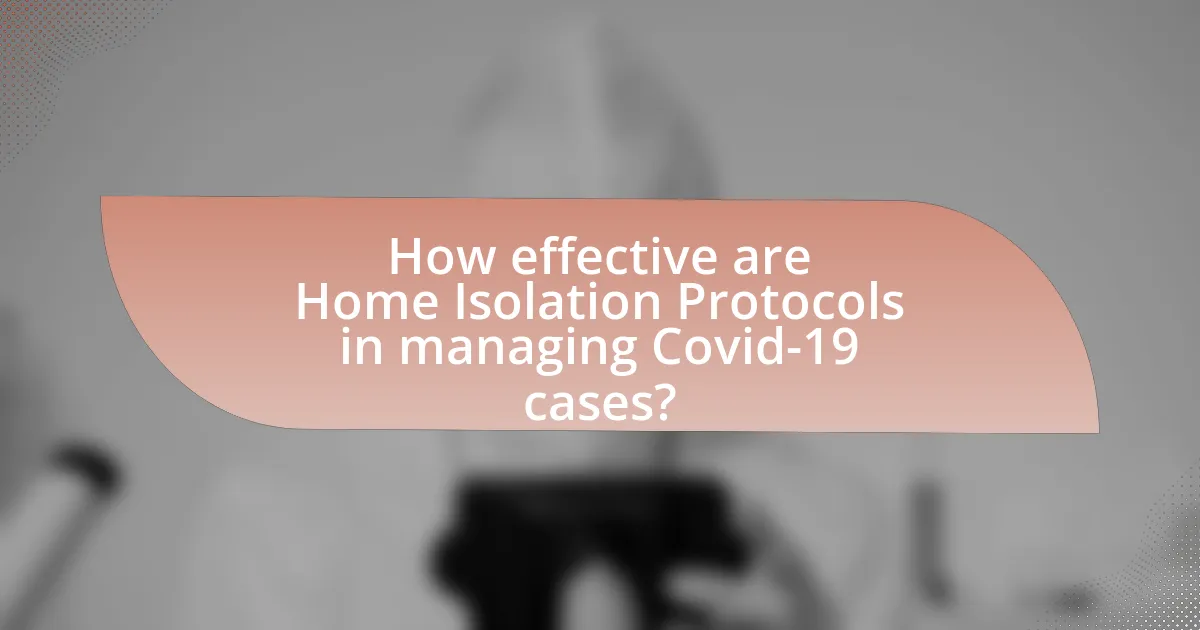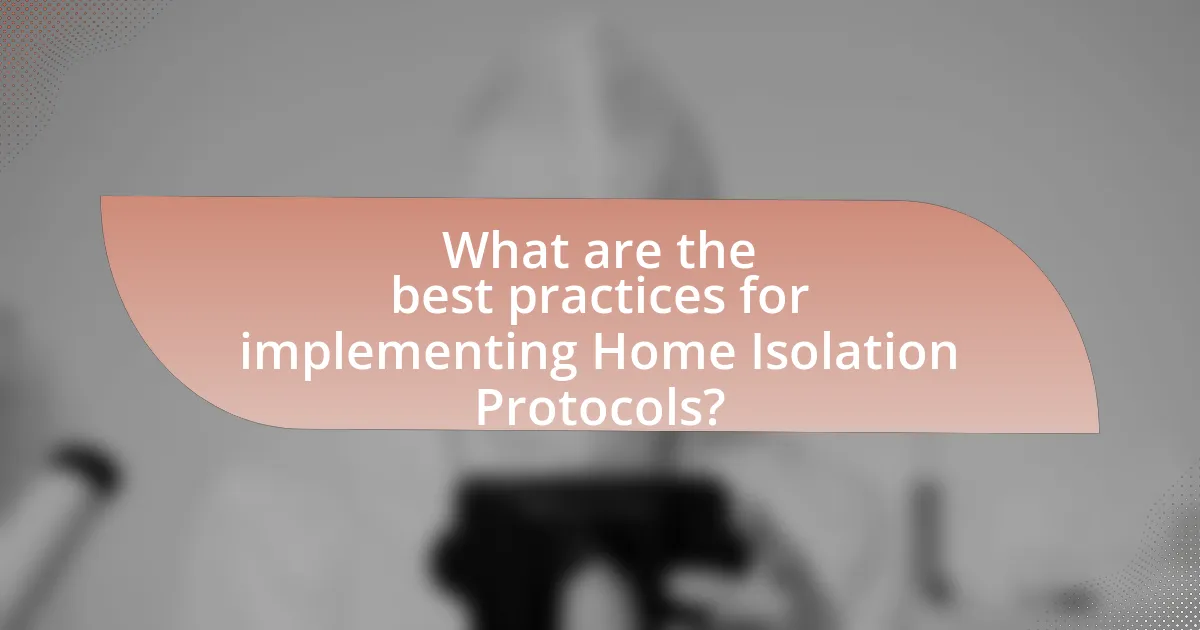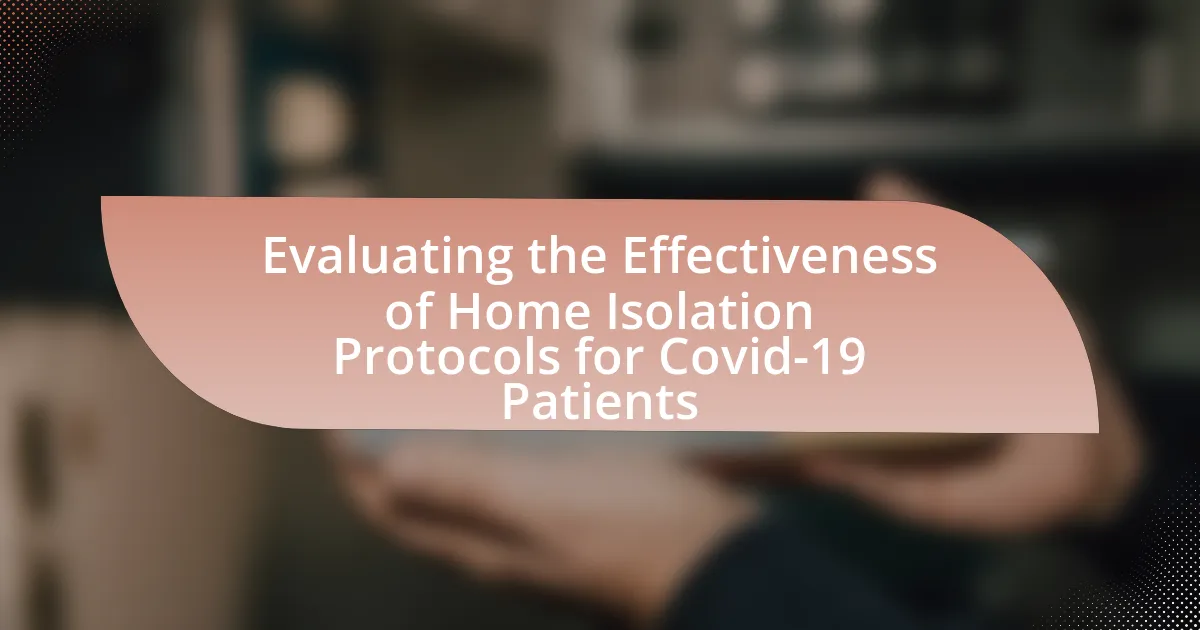Home isolation protocols for Covid-19 patients are essential guidelines aimed at preventing virus transmission while allowing individuals to recover at home. These protocols include measures such as designated isolation rooms, hygiene practices, and symptom monitoring, as recommended by the Centers for Disease Control and Prevention (CDC). The article evaluates the effectiveness of these protocols in managing Covid-19 cases, highlighting their role in reducing transmission rates, the psychological impacts on patients, and the importance of healthcare provider support. Additionally, it discusses best practices for implementation, common challenges faced by patients, and the consequences of non-compliance with isolation measures.

What are Home Isolation Protocols for Covid-19 Patients?
Home isolation protocols for Covid-19 patients involve specific guidelines to prevent the spread of the virus while allowing patients to recover at home. These protocols typically include staying in a designated room away from other household members, using a separate bathroom if possible, wearing a mask when in shared spaces, and practicing good hygiene, such as frequent handwashing and disinfecting surfaces. The Centers for Disease Control and Prevention (CDC) recommends that individuals with Covid-19 isolate for at least 10 days from the onset of symptoms and until they have been fever-free for 24 hours without the use of fever-reducing medications. These measures are designed to minimize transmission risks and protect vulnerable individuals in the household.
How are Home Isolation Protocols defined and implemented?
Home Isolation Protocols are defined as guidelines established to manage and contain the spread of infectious diseases, particularly for individuals diagnosed with Covid-19. These protocols are implemented by instructing patients to remain at home, avoid contact with others, and follow specific health guidelines, such as monitoring symptoms and maintaining hygiene practices. For instance, the Centers for Disease Control and Prevention (CDC) outlines that individuals should isolate themselves in a separate room, use a separate bathroom if possible, and wear masks when around others. This structured approach aims to minimize transmission risks while allowing patients to recover in a familiar environment.
What guidelines are recommended for effective home isolation?
Effective home isolation guidelines include staying in a designated room away from others, using a separate bathroom if possible, and wearing a mask when interacting with others. These measures help prevent the spread of COVID-19 within the household. The Centers for Disease Control and Prevention (CDC) recommends that individuals in isolation monitor their symptoms, avoid sharing personal items, and ensure good ventilation in their isolation area to minimize the risk of transmission.
What roles do healthcare providers play in home isolation?
Healthcare providers play critical roles in home isolation by monitoring patient health, providing medical guidance, and ensuring adherence to isolation protocols. They conduct regular assessments through telehealth consultations, allowing for timely interventions if a patient’s condition worsens. Additionally, healthcare providers educate patients and their families about symptoms to watch for, proper hygiene practices, and when to seek emergency care. This support is essential for managing Covid-19 patients effectively at home, as evidenced by studies showing that structured telehealth interventions can reduce hospitalizations and improve patient outcomes during home isolation.
Why are Home Isolation Protocols important during a pandemic?
Home Isolation Protocols are important during a pandemic because they help prevent the spread of infectious diseases, such as COVID-19, by isolating individuals who are infected or symptomatic. By keeping these individuals at home, the risk of transmission to others in the community is significantly reduced. Studies have shown that effective home isolation can lower the reproduction number of a virus, thereby controlling outbreaks. For instance, the Centers for Disease Control and Prevention (CDC) emphasizes that isolating infected individuals is crucial for public health safety, as it minimizes contact with healthy individuals and reduces the overall burden on healthcare systems.
How do these protocols help in controlling the spread of Covid-19?
Home isolation protocols help control the spread of Covid-19 by minimizing contact between infected individuals and the general population. These protocols require patients to remain at home, thereby reducing the likelihood of virus transmission in public spaces. Studies indicate that effective home isolation can lead to a significant decrease in secondary infections; for instance, a study published in the journal “Nature” found that proper isolation practices reduced transmission rates by up to 80%. By limiting interactions and ensuring that infected individuals follow guidelines, these protocols play a crucial role in curbing the spread of the virus.
What are the psychological impacts of home isolation on patients?
Home isolation significantly impacts the psychological well-being of patients, leading to increased feelings of anxiety, depression, and loneliness. Research indicates that prolonged isolation can exacerbate pre-existing mental health conditions and create new psychological challenges, as evidenced by a study published in the Journal of Medical Internet Research, which found that 47% of individuals in isolation reported psychological distress. Additionally, the lack of social interaction and support during home isolation can lead to a sense of helplessness and decreased motivation, further compounding mental health issues.

How effective are Home Isolation Protocols in managing Covid-19 cases?
Home Isolation Protocols are effective in managing Covid-19 cases by reducing transmission rates and allowing for patient monitoring in a controlled environment. Studies indicate that when patients adhere to isolation guidelines, the risk of spreading the virus to household members decreases significantly. For instance, research published in the Journal of Infectious Diseases found that proper home isolation can lower secondary infection rates by up to 80% when combined with other preventive measures. This effectiveness is further supported by data from the Centers for Disease Control and Prevention, which emphasizes the importance of isolation in mitigating the spread of Covid-19 within communities.
What metrics are used to evaluate the effectiveness of home isolation?
Metrics used to evaluate the effectiveness of home isolation include adherence rates, symptom monitoring, transmission rates, and healthcare utilization. Adherence rates measure how consistently individuals follow isolation guidelines, which is crucial for preventing virus spread. Symptom monitoring tracks the severity and duration of symptoms in isolated individuals, providing insight into the effectiveness of isolation in managing illness. Transmission rates assess the number of new infections linked to isolated individuals, indicating the success of isolation in curbing the spread of Covid-19. Healthcare utilization metrics, such as hospital admissions and emergency room visits, reflect the impact of home isolation on the overall healthcare system. These metrics collectively provide a comprehensive evaluation of home isolation protocols.
How do recovery rates compare between home isolation and hospitalization?
Recovery rates for COVID-19 patients in home isolation are generally comparable to those in hospitalization for mild to moderate cases. Studies indicate that patients with mild symptoms can recover effectively at home, with recovery rates around 90% or higher, while hospitalized patients, particularly those with severe symptoms, have varied recovery rates depending on underlying health conditions and treatment received. For instance, a study published in the Journal of the American Medical Association found that home isolation can lead to similar outcomes as hospitalization for non-severe cases, emphasizing the importance of monitoring and support during home recovery.
What factors influence the success of home isolation protocols?
The success of home isolation protocols is influenced by several key factors, including adherence to guidelines, availability of resources, and social support systems. Adherence to guidelines ensures that individuals follow necessary precautions, such as maintaining distance from others and monitoring symptoms, which is critical for preventing virus transmission. Availability of resources, such as medical supplies and access to healthcare, supports individuals in managing their health effectively during isolation. Social support systems, including family and community assistance, enhance emotional well-being and compliance with isolation measures. Research indicates that these factors significantly impact the effectiveness of home isolation in controlling the spread of Covid-19, as evidenced by studies showing lower transmission rates in households with strong adherence and support networks.
What challenges do patients face during home isolation?
Patients face several challenges during home isolation, including mental health issues, lack of access to medical care, and difficulties in managing daily activities. Mental health challenges, such as anxiety and depression, can arise due to social isolation and uncertainty about health outcomes. A study published in the Journal of Medical Internet Research found that 30% of individuals in home isolation reported significant psychological distress. Additionally, patients may struggle to access necessary medical support, as remote consultations can be limited and in-person visits may be discouraged. Furthermore, managing daily tasks like cooking, cleaning, and self-care can become overwhelming, especially for those experiencing severe symptoms. These factors collectively hinder the effectiveness of home isolation protocols for Covid-19 patients.
How can patients manage symptoms effectively at home?
Patients can manage symptoms effectively at home by following a structured approach that includes monitoring their health, staying hydrated, and using over-the-counter medications as needed. Regularly checking temperature and symptoms helps patients identify any worsening conditions early. Hydration is crucial, as it aids in recovery and alleviates symptoms like fever and cough. Over-the-counter medications, such as acetaminophen or ibuprofen, can help reduce fever and relieve pain. According to the Centers for Disease Control and Prevention (CDC), these self-care measures are essential for managing mild symptoms of COVID-19 at home, ensuring patients maintain comfort and monitor their health effectively.
What support systems are available for patients in home isolation?
Support systems available for patients in home isolation include telehealth services, which provide remote medical consultations, and delivery services for medications and groceries. Telehealth allows patients to receive medical advice and monitoring without leaving home, ensuring they have access to healthcare professionals. Additionally, community support networks often offer assistance with daily tasks, such as meal preparation and emotional support, helping to alleviate the challenges of isolation. These systems are crucial for maintaining the health and well-being of individuals during their recovery at home.

What are the best practices for implementing Home Isolation Protocols?
The best practices for implementing Home Isolation Protocols include ensuring that individuals with confirmed or suspected COVID-19 have a designated space away from others, maintaining communication with healthcare providers, and adhering to hygiene and sanitation measures. Designating a separate room minimizes the risk of virus transmission to other household members, as supported by the Centers for Disease Control and Prevention (CDC) guidelines. Regular communication with healthcare providers allows for monitoring symptoms and receiving guidance on care, which is crucial for effective management of the illness. Additionally, practicing good hygiene, such as frequent handwashing and disinfecting surfaces, is essential to reduce the spread of the virus within the home. These practices collectively enhance the effectiveness of home isolation in controlling COVID-19 transmission.
How can families support a member in home isolation?
Families can support a member in home isolation by providing emotional support, ensuring access to necessities, and maintaining communication. Emotional support can be offered through regular check-ins via phone or video calls, which helps alleviate feelings of loneliness and anxiety. Ensuring access to necessities involves delivering food, medications, and hygiene products, which is crucial for the isolated individual’s well-being. Maintaining communication through various channels fosters a sense of connection and helps the isolated member feel cared for, which is essential for mental health during isolation.
What resources are available for families to ensure safety and compliance?
Families can access various resources to ensure safety and compliance during home isolation for COVID-19 patients. These resources include guidelines from the Centers for Disease Control and Prevention (CDC), which provide detailed instructions on isolation protocols, hygiene practices, and monitoring symptoms. Additionally, local health departments often offer support services, including hotlines for questions and mental health resources. Community organizations may also provide assistance with food delivery and medical supplies, ensuring that families can adhere to isolation requirements without compromising their health or safety.
How can technology assist in monitoring and supporting isolated patients?
Technology can assist in monitoring and supporting isolated patients by providing remote health monitoring tools, telehealth services, and communication platforms. Remote health monitoring tools, such as wearable devices, enable continuous tracking of vital signs like heart rate and oxygen levels, allowing healthcare providers to detect any deterioration in a patient’s condition promptly. Telehealth services facilitate virtual consultations, ensuring that patients receive medical advice and support without needing to leave their homes, which is crucial during isolation periods. Communication platforms, including messaging apps and video calls, help maintain social connections, reducing feelings of loneliness and anxiety among isolated patients. Studies have shown that these technologies can improve patient outcomes by enhancing access to care and fostering emotional support, which is particularly important for individuals in home isolation due to Covid-19.
What common mistakes should be avoided during home isolation?
Common mistakes to avoid during home isolation include neglecting to follow hygiene protocols, failing to monitor symptoms, and not maintaining communication with healthcare providers. Neglecting hygiene, such as not regularly washing hands or disinfecting surfaces, increases the risk of virus transmission within the household. Failing to monitor symptoms can lead to worsening health conditions without timely medical intervention. Additionally, not maintaining communication with healthcare providers can result in missed guidance on managing symptoms or recognizing when to seek further care. These mistakes can undermine the effectiveness of home isolation protocols, which are designed to prevent the spread of Covid-19 and ensure patient safety.
How can misinformation impact the effectiveness of home isolation?
Misinformation can significantly undermine the effectiveness of home isolation by leading individuals to disregard essential health guidelines. For instance, false beliefs about the virus’s transmission can result in people not adhering to isolation protocols, thereby increasing the risk of spreading COVID-19. A study published in the journal “Health Communication” found that misinformation about COVID-19 led to confusion regarding symptoms and preventive measures, which directly affected compliance with isolation recommendations. This noncompliance can exacerbate public health crises by facilitating further transmission of the virus within communities.
What are the consequences of not following isolation protocols?
Not following isolation protocols can lead to increased transmission of infectious diseases, particularly in the context of Covid-19. When individuals do not adhere to these protocols, they risk spreading the virus to others, which can result in higher infection rates within communities. According to the Centers for Disease Control and Prevention (CDC), failure to isolate can contribute to outbreaks, overwhelming healthcare systems and leading to more severe health outcomes for vulnerable populations. Additionally, non-compliance with isolation measures can prolong the duration of the pandemic, as it hinders efforts to control the spread of the virus.
What practical tips can enhance the effectiveness of home isolation?
To enhance the effectiveness of home isolation, individuals should establish a dedicated isolation space, maintain strict hygiene practices, and monitor health symptoms regularly. A dedicated isolation space minimizes the risk of virus transmission to other household members, while strict hygiene practices, such as frequent handwashing and disinfecting surfaces, reduce the likelihood of contamination. Regular health monitoring, including tracking symptoms and temperature, ensures timely medical intervention if conditions worsen. These practices are supported by guidelines from health organizations, which emphasize the importance of isolation and hygiene in controlling the spread of Covid-19.


